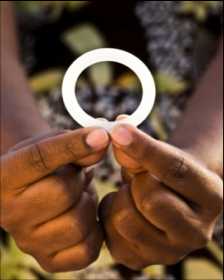22 Feb Antiretroviral Vaginal Ring May Become HIV Prevention Tool For Women
MedicalResearch.com Interview with:
Jared Baeten, MD PhD
Vice Chair, Department of Global Health
Professor, Departments of Global Health, Medicine, and Epidemiology
Co-Director, International Clinical Research Center
University of Washington
MedicalResearch.com: What is the background for this studies?
Dr. Baeten: Women account for nearly 60 percent of adults with HIV in sub-Saharan Africa, where unprotected heterosexual sex is the primary driver of the epidemic. While several studies have shown that antiretroviral medications (ARVs) are highly effective in preventing HIV, other studies – such as VOICE and FACTS 001 – suggest that for young, at-risk women in Africa, ARVs delivered as a vaginal gel or as a tablet may not be acceptable. Products must be used to be effective, and that was not the case for most of the participants in previous studies.
Medical Research: What was the aim of ASPIRE and The Ring Study?
Dr. Baeten: As Phase III clinical trials, ASPIRE and The Ring Study were designed to determine whether a vaginal ring containing an antiretroviral (ARV) drug called dapivirine is safe and effective in protecting women against HIV when used for a month at a time. These trials also sought to determine whether women find the vaginal ring practical and easy to use. As sister studies, ASPIRE and The Ring Study were designed as the centerpiece of a broader licensure program to provide the strength of evidence to support potential licensure of the dapivirine vaginal ring for preventing HIV in women. Because at least two Phase III efficacy trials are usually needed for a product to be considered for regulatory approval, ASPIRE and The Ring Study were conducted in parallel to accelerate the timeline to the ring’s potential approval.
Medical Research: What is the dapivirine vaginal ring?
Dr. Baeten: Vaginal rings are flexible products that fit high inside the vagina and allow for the slow, continuous delivery of a drug or multiple drugs over a period of weeks or months. In the U.S. and Europe, vaginal ring products are licensed for both contraception delivery and hormone replacement. Women can insert and remove the ring themselves.
The dapivirine ring is designed to offer potentially long-acting protection against HIV. Each ring contains 25mg of the antiretroviral medications dapivirine. When placed inside the vagina, the ring slowly releases the drug over the course of four weeks. The ring is made of flexible silicone and measures 56mm (about 2 ¼ inches) in diameter and 7.7mm thick (3/8 inch).
MedicalResearch: What should clinicians and patients take away from your report?
Dr. Baeten: These results represent a first: a female-controlled HIV prevention strategy, effective and safe in two studies. The dapivirine vaginal ring could become an HIV prevention option for women, particularly in Africa where HIV risk is high and prevention options are often limited.
Medical Research: What recommendations do you have for future research as a result of this study?
Dr. Baeten: One important next step is to evaluate the dapivirine vaginal ring in open-label studies, since adherence (and consequently HIV protection) may be higher than in a blinded, placebo controlled trial, where HIV protection was unknown. Particularly important would be studies in young women.
Medical Research: Is there anything else you would like to add?
Dr. Baeten: Women in this study frequently spoke about how important it was to develop new HIV prevention options for their communities and how easy this ring was to use.
Citation:
Use of a Vaginal Ring Containing Dapivirine for HIV-1 Prevention in Women
February 22, 2016DOI: 10.1056/NEJMoa1506110
[wysija_form id=”5″]
Jared Baeten, MD PhD (2016). Antiretroviral Vaginal Ring May Become HIV Prevention Tool For Women
Last Updated on February 22, 2016 by Marie Benz MD FAAD


